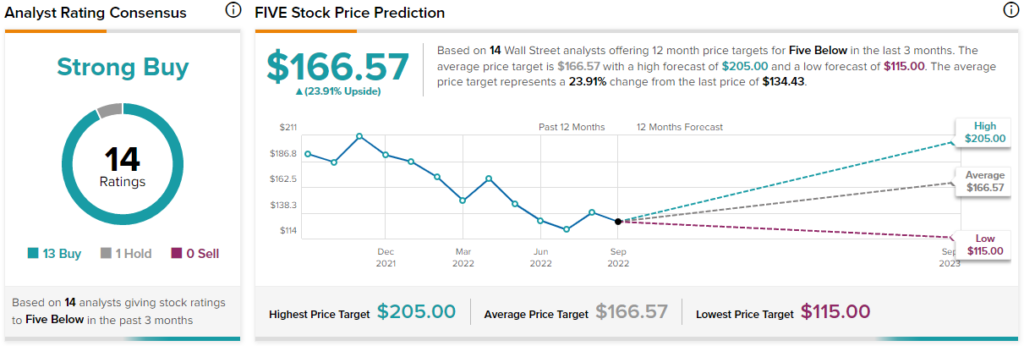Recession fears have been dominating the headlines of late. Interest rate hikes and decaying corporate earnings are heavily-discussed topics, and investors are hitting the panic button as the broader stock market retests the lows not seen since summer. Therefore, in this article, we used TipRanks’ Comparison Tool to check out three discount retailers favored by Wall Street — FIVE, COST, and DG, ahead of a potential recession year. Based solely on analyst price targets, FIVE stock looks the most promising. However, let’s dive deeper.
Discover the Best Stocks and Maximize Your Portfolio:
- See what stocks are receiving strong buy ratings from top-rated analysts.
- Filter, analyze, and streamline your search for investment opportunities with TipRanks’ Stock Screener.

With the June-August relief rally gains now wiped out, questions linger as to what the market’s next move will be. Market strategists and various big banks have been quick to lower the bar on their price targets for the S&P 500 (SPX). Eventually, we may enter a recession without even knowing it. Though a recession will weigh on sales and earnings growth for some time, I do think much of the damage has already been factored into markets here, with the S&P 500 off nearly 25%.
With almost every asset class under pressure, investors face a tough task as they look to put excess cash loads to work. The defensive consumer staples and utilities have been intriguing places to “hide” from the economic hailstorm. That said, valuations are fair at best in a market that’s arguably full of bargains.
At this juncture, it’s tough to tell what’s a bargain and what’s a value trap that could implode further once the recession does kick in. That’s why it may be wise to stick with low-cost retailers that stand to continue pushing higher, even as the recession rolls around.
Five Below (NASDAQ: FIVE)
Five Below is a discount retailer that’s faced a considerable amount of turbulence in recent months. The stock has now shed more than 42% of its value after partially recovering from a 50% haircut. As a growth-focused discount retailer that’s had more than its fair share of inflation issues, the excessive downside in the name should come as no surprise.
Though demand for Five Below’s goods won’t sink in the face of a recession as it would for a luxury furnishing retailer, it’s now safe to say that the stock probably should have never reached the valuation it did in the back half of 2021.
Undoubtedly, Five Below was a growth stock with a suspect multiple. Anything with an ambitious growth profile has been crushed. Fortunately, the new line in the sand for FIVE stock seems more than worth getting behind. At writing, shares trade at a more reasonable 31.9x trailing earnings. It’s still priced for growth, but the recent Q2 quarterly flop ($0.74 EPS vs. $0.78 consensus) likely has investors overweighing the negatives.
From a longer-term vantage point, Five Below is still a great company that offers intriguing merchandise catered to young people for a relatively low price. Amid high inflation and economic pressures, it’s price certainty that could help the stock bottom out far sooner than expected.
What is the Price Target for FIVE Stock?
Wall Street remains a believer in Five Below, with a “Strong Buy” consensus and an average FIVE stock price target of $166.57, implying 23.9% upside potential from here. The stock sports 13 Buys and one Hold rating.

Costco (NASDAQ: COST)
Costco is a big-box retailer that needs no introduction. Consumers have flocked to the retailer to save money amid the inflationary hailstorm that hit us over the past few years. As inflation nosedives, many customers that signed up with Costco will not be quick to depart.
Indeed, many consumers have discovered that a Costco membership essentially pays for itself. The value to be had is tough to stack up against, given Costco’s strong purchasing power and willingness to undercut rivals in the retail space.
In the business of retail, staying competitive on pricing is key. As a recession or stagflation strike, I’d look for Costco to continue taking share away from other retailers that fail to keep up.
The only knock against Costco stock is that it’s not cheap. Even after shedding around 21% of its value, the stock trades at 37.7x trailing earnings. There’s a lot of recession resilience and growth still baked into the stock. Undoubtedly, the market has better deals out there, but in terms of certainty in a recession, it’s tough to top Costco. I think shares are worth every penny of their premium at a time like this.
What is the Price Target for COST Stock?
Wall Street agrees, with a “Strong Buy” rating and a $558.75 average COST stock price target, implying 16.8% upside potential.

Dollar General (NYSE: DG)
Dollar General is the gold standard when it comes to discount retail. Inflation, recession jitters, and exceptional management helped the firm clock in 4.6% in same-store sales growth (SSSG) in its most recent quarter.
As the economic downturn looms, Dollar General is one of few firms that can continue driving its sales growth higher. Unlike Five Below, Dollar General seems more resilient in the face of a recession. The consumables mix is quite large. With cold storage and frozen foods garnering more intrigue, Dollar General may very well be one of the more defensive staples to consider in a harsher-than-expected economic environment.
At writing, shares of Dollar General trade at 23.5x trailing earnings, making it the cheapest of the three low-cost retailers in this piece. Down just 10% from its highs, Dollar General has been a relative pillar of stability for this market. Moving ahead, investors and analysts will expect more of the same.
What is the Price Target for DG Stock?
Wall Street loves Dollar General, with a “Strong Buy” consensus on shares based on 13 Buys and four Holds. The average DG stock price target of $276.31 implies 17.15% upside potential over the year ahead.

Conclusion: Analysts are Most Bullish on FIVE Stock
Discount retail stocks could hold their own as economies tilt into recession. Of the three stocks in this piece, Five Below has the most upside potential through the eyes of analysts.









